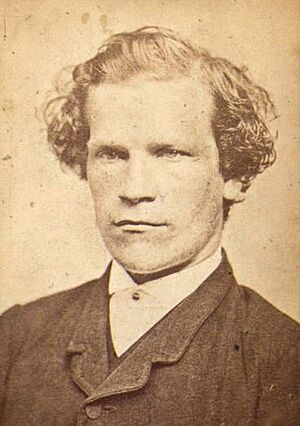Franz Müller facts for kids
Quick facts for kids
Franz Müller
|
|
|---|---|
 |
|
| Born | 31 October 1840 |
| Died | 14 November 1864 (aged 24) London, England
|
| Nationality | German |
| Occupation | Tailor |
| Criminal charge(s) | Murder |
Franz Müller (born October 31, 1840 – died November 14, 1864) was a tailor from Germany. He became famous for a very important case in British history. He was found responsible for the first-ever serious crime that happened on a British train. This event made people worry a lot about how safe train travel was. The police, especially Scotland Yard, chased Müller all the way across the Atlantic Ocean to New York City to bring him back.
Contents
How the Police Found Out
On July 18, a taxi driver named Matthews told the police about a German man, Franz Müller. Matthews said that Müller, who was 24 years old, had come to his house with a gold chain. The taxi driver had attached his fob watch to the chain.
A jeweller in Cheapside had sold the box the chain came in. This jeweller recognized Müller from a photo. He told the police that Müller had visited his shop on July 11. Müller had wanted to exchange a gold chain. This chain was later identified as belonging to the victim. With this important information, the police got a special paper, called a warrant, to arrest Müller.
A Chase Across the Ocean
However, by the time the police had the warrant, Müller had already left. He had boarded a sailing ship called Victoria and was heading to New York City.
On July 20, a police inspector from Scotland Yard, Richard Tanner, started his own journey. He sailed from Liverpool to New York on a faster ship, the City of Manchester. The taxi driver, Matthews, and the jeweller went with him. Because their ship was much faster, they arrived in New York three weeks before Müller's ship.
When Müller finally arrived in Manhattan on August 25, he was arrested right away. Among his things, the police found the victim's gold watch and a hat. Müller had tried to change the hat by cutting it shorter and sewing it back together. An American judge agreed to send Müller back to Britain. This process is called extradition.
The Trial
Most of the evidence against Müller was based on clues, not direct proof. This is called circumstantial evidence. However, the prosecutor, Mr. Serjeant Ballantine, presented a very strong case. The lawyers defending Müller tried to say that the taxi driver, Matthews, only came forward to get a reward. But this argument did not convince the court.
Müller kept saying he was innocent during his three-day trial at the Old Bailey court. After the trial, the court decided he was responsible for the crime. He faced the highest penalty allowed by law at the time. King Wilhelm I of Prussia (who later became the Kaiser of Germany) tried to get the British Government to delay Müller's penalty, but he was not successful.
What Happened Next
The public penalty for Müller took place outside Newgate Prison in London on November 14. Many people came to watch.
What Changed Because of This Case
The victim had been attacked in a train compartment that was closed off. There was no way to leave the compartment until the train reached the next station. Because of this case, people demanded changes to train safety.
- A new invention called the communication cord was added to trains. This allowed passengers to contact the train crew if there was a problem. This became a rule because of the Regulation of Railways Act 1868.
- Train carriages also started to have side corridors. This meant passengers could walk around and move between compartments while the train was moving.
- Some older train compartments were changed to have small, round windows in the walls. These were called "Müller's Lights."
- For a while, a hat with a low crown, like a cut-down top hat, became known as a Muller. This was because Müller had tried to change the victim's hat in this way.
This famous case was featured in a 2013 BBC documentary called Murder On The Victorian Railway. It was also the first episode of a TV show called Railway Murders, which first aired on the Yesterday channel in 2021.
Images for kids


